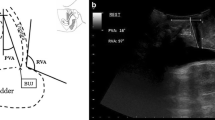Abstract
The objective of this study was to demonstrate the differences in the urethrovesical junction angle and urethral mobility by means of perineal ultrasounds in women following vaginal delivery with respect to nulliparous women. We have enrolled 34 women, 12 nulliparous (Group A) and 22 women in the post-partum period (Group B). The ultrasounds were employed to measure the urethrovesical junction angle (“urethro-pelvic” angle) and the urethral mobility. Data obtained show that the urethro-pelvic angle is narrower in Group A (97.3°) with respect to Group B (112.5°). Urethral mobility while coughing was significantly higher in Group B (30.4°) with respect to Group A (−2°). This study demonstrates the difference in the urethral support at rest and during cough in nulliparous versus recently delivered parous women.






Similar content being viewed by others
References
Olsen AL, Smith VJ, Bergstrom JO, Colling JC, Clark AL (1997) Epidemiology of surgically managed pelvic organ prolapse and urinary incontinence. Obstet Gynaecol 89:501–506
Reay Jones NH, Healy JC, King LJ, Saini S, Shousha S, Allen-Mersh TG (2003 Apr) Pelvic connective tissue resilience decreases with vaginal delivery, menopause and uterine prolapse. Br J Surg 90(4):466–472
Sultan AH, Kamm MA, Hudson CN, Bartram CI (1994) Third degree obstetric anal sphincter tears: risk factor and outcome of primary repair. BMJ 308:887–891
Handa VL, Harris TA, Ostergard DR (1996) Protecting the pelvic floor obstetric management to prevent incontinence and pelvic organ prolapse. Obstet Gynaecol 88:470–478
Jameson JS, Chia YW, Kamm MA, Speakman CTM, Chye YH, Henry MM (1994) Effect of age, sex and parity on anorectal function. Br J Surg 81:1689–1692
Otcenasek M, Halaska M, Kremar M, Maresova D, Halaska MG (2002) New approach to the urogynecological ultrasound examination. Obstet Gynaecol 103:72–74
Pregazzi R, Sartore A, Bortoli P, Grimaldi E, Troiano L, Guaschino S (2002) Perineal ultrasound evaluation of urethral angle and bladder neck mobility in women with stress incontinence. BJOG 109:821–827
Wisser J, Schar G, Kurmanavicius J, Huch R, Huch A (1999) Use of 3D ultrasound as a new approach to asses obstetrical trauma to the pelvic floor. Ultraschall Med 20:15–18
Ochsenbein N, Kurmanavicius J, Huch R, Huch A, Wisser J (2001) Volume sonography of the pelvic floor in nulliparous women and after elective cesarean section. Acta Obstet Gtnecol Scand 80:611–615
Howard D, Miller JM, De Lancey JOL, Ashton-Miller JA (2000) Differential effects of cough, Valsalva, and continence status on vesical neck movement. Obstet Gynaecol 95(4):535–540
Miller JM, Perucchini D, Carchidi LT, De Lancey JOL, Ashton-Miller JA (2001) Pelvic floor muscle contraction during a cough and decreased vesical neck mobility. Obstet Gynecol 97(2):255–260
Brink CA, Wells TJ, Sampselle CM, Taillie ER, Mayer R (1994) A digital test for pelvic muscle strength in women with urinary incontinence. Nurs Res 43: 352–256
Tunn R, DeLancey OL, Howard D, Thorp JM, Ashton-Miller JA, Quint LE (1999) MR Imaging of levator ani muscle recovery following vaginal delivery. Int Urogynecol J 10:300–307
Sartore A, Pregazzi R, Bortoli P, Grimaldi E, Ricci G, Guaschino S (2002) The urine stream interruption test and pelvic muscle function in the puerperium. Int J Gynecol Obstet 78:235–239
Schaer GN, Koechli OR, Schuessler B, Haller U (1996) Perineal ultrasound: determination of reliable examination procedures. Ultrasound Obstet Gynecolol 7:347–352
Peschers U, Schaer G, Anthuber C, Delancey JO, Schuessler B (1996) Changes in vesical neck mobility following vaginal delivery. Obstet Gynecol 88(6):1001–1006
Author information
Authors and Affiliations
Corresponding author
Rights and permissions
About this article
Cite this article
Costantini, S., Nadalini, C., Esposito, F. et al. Perineal ultrasound evaluation of the urethrovesical junction angle and urethral mobility in nulliparous women and women following vaginal delivery. Int Urogynecol J 16, 455–459 (2005). https://doi.org/10.1007/s00192-005-1285-6
Received:
Accepted:
Published:
Issue Date:
DOI: https://doi.org/10.1007/s00192-005-1285-6




